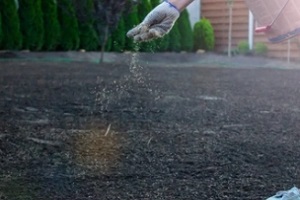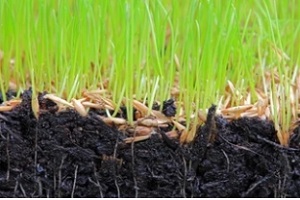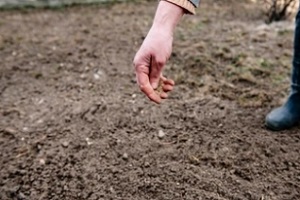 Your yard is one of the first things passers-by and visitors see when they approach your home. Having a nice and well-maintained lawn is a great way to make a great impression. Although grass grows quickly, it is important to ensure it is planted correctly to have the best chance of growing into a full, healthy lawn.
Your yard is one of the first things passers-by and visitors see when they approach your home. Having a nice and well-maintained lawn is a great way to make a great impression. Although grass grows quickly, it is important to ensure it is planted correctly to have the best chance of growing into a full, healthy lawn.
Every planting project, whether it is a vegetable garden, a flower bed, or a grassy area, needs to begin with the right type and amount of soil. When it comes to planting grass, there are a few things you need to keep in mind in terms of topsoil. Here is a closer look at the proper depth and other factors to consider when growing grass.
Why Do You Need Topsoil?
The topsoil is where most of the growing action is going to take place in your yard. Organic matter decays in the topsoil and beneficial microbes live there; both of these processes work together to create the ideal environment for your grass roots to thrive.
How Much Topsoil Do You Need?
For starting a new lawn, if the top 4 to 6 inches of your existing topsoil are rich with organic matter, you can proceed with it. If your garden’s soil is too sandy or it contains heavy clay, however, it is advisable to purchase a higher-quality topsoil to ensure that your lawn will grow without problems.
What to Look for in Topsoil
A high-quality topsoil for growing grass will feel somewhat gritty when rubbed between your fingers. Its color should be very dark or even black, which indicates that it contains enough organic matter to create a good growing environment. Soil that looks or feels sandy or has heavy clay particles that cause it to clump or harden when it dries should be avoided. However, the layer beneath the topsoil, which is known as the subsoil, does not need to be as high in quality as the topsoil.
How Deep Should the Topsoil Be?
Grass roots grow somewhere between 4 and 6 inches long, so applying a layer of topsoil that is at least 6 inches deep will provide the grass with the room it needs for its roots to grow. Keep in mind that if the layer of topsoil is too thin, the grass will only be able to put down shallow roots, which means it is likely to end up with nutrient deficiencies and grow sparsely. This can also make the lawn more vulnerable to the effects of drought and require more frequent watering.
Should the Topsoil Be Worked In?
 It may be tempting to layer topsoil directly over the subsoil beneath it, but this is not advised as it could lead to drainage issues. It is best to till the top 2 or 3 inches of subsoil to loosen it up before laying the topsoil. This is also a good time to level the lawn to remove any low areas and slope it gently away from your home and driveway.
It may be tempting to layer topsoil directly over the subsoil beneath it, but this is not advised as it could lead to drainage issues. It is best to till the top 2 or 3 inches of subsoil to loosen it up before laying the topsoil. This is also a good time to level the lawn to remove any low areas and slope it gently away from your home and driveway.
Then, apply the topsoil across the entire surface in an even 6-inch layer and till it into the loosened subsoil to provide grass with a deep rooting zone. Once the topsoil has been applied, rake it again to make it level and ready for seeding.
Compost can be mixed into topsoil to provide it with more organic matter. Mix a 1-to-3-inch layer of compost into the top 4 to 6 inches of topsoil to help correct soil that is overly sandy or contains too much clay.
Should You Use a Single Variety or a Mix?
While climate should be your primary consideration when choosing a type of grass seed to plant, it is also important to consider the unique properties of your lawn. Be sure to take into account whether your yard is in full sun, shade, or a mix as well as how much moisture it tends to get and the amount of traffic that passes through your yard. Another thing to keep in mind is how much time and effort you are willing to spend maintaining your lawn.
You can purchase seeds in a variety of formats, from pure seeds of just one variety to blends of several types of the same variety or mixtures that have different varieties. While pure grass seed will provide your lawn with a unified look, a blend means that one variety of seed could make up for the weaknesses of another variety. A grass seed mixture, meanwhile, can create a more biologically diverse lawn. It may look less uniform but has a better chance of surviving droughts and diseases.
Some grass seeds come with fertilizer and mulch already incorporated. These options are very convenient but tend to be more expensive.
Bags of grass seed typically indicate the number of pounds needed to cover every 1,000 square feet. Measure your yard, and err on the high side so you have some left over in case you need to add more later to bare spots.
Planting the Grass Seeds
 Hand seeding is sufficient for planting grass seed across a small area, but you will want to use a seeder for bigger areas. You might consider using a drop seeder, a hand-cranked seeder, or a push-from-behind model across particularly large zones.
Hand seeding is sufficient for planting grass seed across a small area, but you will want to use a seeder for bigger areas. You might consider using a drop seeder, a hand-cranked seeder, or a push-from-behind model across particularly large zones.
The bag will indicate how many seeds to use; this is typically around 15 to 20 seeds per square inch. If you will be making two passes across the lawn with the seeder, aim for half the suggested amount each time. It is recommended that you make two passes across the lawn at different angles. For example, if your first pass goes east to west, go north to south on the second pass. This will give the grass seeds the best chance of spreading evenly.
Then, gently rake the seeded surface to mix the grass seed into the top 1/8 inch of soil.
Reach Out to Dirt Connections
Dirt Connections provides the Northern Virginia area with a range of topsoil and fill dirt varieties for projects of all sizes. Get in touch today to discuss your project or schedule a delivery.
Summary

Dirt Connections was started with one goal in mind: providing quality residential and commercial construction services to clients on time and on budget. Reach out for more information on how we can support your next project.
For your convenience our estimates are free and by appointment. Call 703-940-9949 for a free estimate today!










































